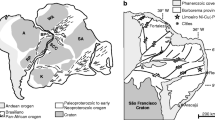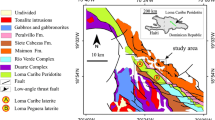Abstract
The Jinbaoshan Pt–Pd deposit in Yunnan, SW China, is hosted in a wehrlite body, which is a member of the Permian (∼260 Ma) Emeishan Large Igneous Province (ELIP). The deposit is reported to contain one million tonnes of Pt–Pd ore grading 0.21% Ni and 0.16% Cu with 3.0 g/t (Pd + Pt). Platinum-group minerals (PGM) mostly are ∼10 μm in diameter, and are commonly Te-, Sn- and As-bearing, including moncheite (PtTe2), atokite (Pd3Sn), kotulskite (PdTe), sperrylite (PtAs2), irarsite (IrAsS), cooperite (PtS), sudburyite (PdSb), and Pt–Fe alloy. Primary rock-forming minerals are olivine and clinopyroxene, with clinopyroxene forming anhedral poikilitic crystals surrounding olivine. Primary chromite occurs either as euhedral grains enclosed within olivine or as an interstitial phase to the olivine. However, the intrusion has undergone extensive hydrothermal alteration. Most olivine grains have been altered to serpentine, and interstitial clinopyroxene is often altered to actinolite/tremolite and locally biotite. Interstitial chromite grains are either partially or totally replaced by secondary magnetite. Base-metal sulfides (BMS), such as pentlandite and chalcopyrite, are usually interstitial to the altered olivine. PGM are located with the BMS and are therefore also interstitial to the serpentinized olivine grains, occurring within altered interstitial clinopyroxene and chromite, or along the edges of these minerals, which predominantly altered to actinolite/tremolite, serpentine and magnetite. Hydrothermal fluids were responsible for the release of the platinum-group elements (PGE) from the BMS to precipitate the PGM at low temperature during pervasive alteration. A sequence of alteration of the PGM has been recognized. Initially moncheite and atokite have been corroded and recrystallized during the formation of actinolite/tremolite, and then, cooperite and moncheite were altered to Pt–Fe alloy where they are in contact with serpentine. Sudburyite occurs in veins indicating late Pd mobility. However, textural evidence shows that the PGM are still in close proximity to the BMS. They occur in PGE-rich layers located at specific igneous horizons in the intrusion, suggesting that PGE were originally magmatic concentrations that, within a PGE-rich horizon, crystallized with BMS late in the olivine/clinopyroxene crystallization sequence and have not been significantly transported during serpentinization and alteration.




Similar content being viewed by others
References
Allen DE, Seyfried WE Jr (2003) Compositional controls on vent fluids from ultramafic-hosted hydrothermal systems at mid-ocean ridges: an experimental study at 400°C, 500 bars. Geochim Cosmochim Acta 67:1531–1542
Andersen JCØ, Rassmussen H, Nielsen TED, Rønsbo JC (1998) The triple group and the Platinova gold and palladium reefs in the Skaergaard intrusion: stratigraphic and petrographic relations. Econ Geol 93:488–509
Augé T, Salpeteur I, Bailly L, Mukherjee MM, Patra RN (2002) Magmatic and hydrothermal platinum-group minerals and base-metal sulphides in the Baula complex, India. Can Miner 40:277–309
Ballhaus CG, Stumpfl EF (1986) Sulphide and platinum mineralization in the Merensky reef: evidence from hydrous silicates and fluid inclusions. Contrib Mineral Petrol 26:447–450
Barnes S-J, Maier WD, Ashwal AD (2004) Platinum-group elements distribution in the Main and Upper zone of the Bushveld Complex. Chem Geol 208:293–317
Bezmen NI, Asif M, Brugmann GE, Romanenko IM, Naldrett AJ (1994) Distribution of palladium, rhodium, ruthenium, iridium, osmium and gold between sulphide and silicate melts. Geochim Cosmochim Acta 58:1251–1260
Boudreau AE, Mathez EA, McCallum IS (1986) Halogen geochemistry of the Stillwater and Bushveld complexes: evidence for the transport of the platinum-group elements by Cl-rich fluids. J Petrol 27:967–986
Boudreau AE, McCallum IS (1992) Concentration of platinum-group elements by magmatic fluids in layered intrusions. Econ Geol 87:1830–1848
Cabri LJ (2002) The platinum-group minerals. In: Cabri LJ (ed) The geology, geochemistry, mineralogy and mineral beneficiation of platinum-group elements. Can Inst Min Metal Petrol Spec Vol 54:13–130
Cabri LJ, Laflamme JHG (1984) Mineralogy and distribution of platinum-group elements in mill products from Sudbury. In: Park WC, Hausen DM, Hagni RD (eds) Proceedings of the second international congress on applied mineralogy in the minerals industry, p 22–25
Campbell IH, Barnes SJ (1984) A model for the geochemistry of the platinum group elements in magmatic sulphide deposits. Can Miner 22:151–160
Campbell IH, Naldrett AJ, Barnes SJ (1983) A model for the origin of the platinum rich sulphide horizons in the Bushveld and Stillwater Complexes. J Petrol 24:133–165
Corrivaux L, Laflamme JHG (1990) Minéralogie des éléments du groupe du platine dans les chromitites de l’ophiolite de Thetford Mines, Québec. Can Miner 28:579–595
Czamanske GK, Kunilov VE, Zientek MI, Cabri LJ, Likhachev AP, Calk LC, Oscarson RL (1992) A proton-microprobe study of magmatic sulphide ores from the Noril’sk-Talnakh district, Siberia. Can Miner 30:249–287
Dilek Y, Coulton A, Hurst SD (1997) Serpentinization and hydrothermal veining in peridotites at Site 920 in the MARK area. In: Karson JA, Cannat M, Miller DJ, Elthon D (eds) Proc ODP Sci Results 153: College Station, TX (Ocean Drilling Program), pp 35–59
Evans BW (1977) Metamorphism of alpine peridotite and serpentinite. Annu Rev Earth Planet Sci 5:398–447
Farrow CEG, Lightfoot PC (2002) Sudbury PGE revisited: toward an integrated model. In: Cabri LJ (ed) The geology, geochemistry, mineralogy and mineral beneficiation of platinum-group elements. Can Inst Min Metal Petrol Spec Vol 54:273–298
Li C, Naldrett AJ, Coats CJA, Johannessen P (1992) Platinum, palladium, gold and copper-rich stringers at the strathcona mine, Sudbury: their enrichment by fractionation of a sulphide liquid. Econ Geol 87:1584–1598
Li C, Ripley EM, Merino E, Maier WD (2004) Replacement of base metal sulphides by actinolite, epidote, calcite, and magnetite in the UG2 and Merensky reef of the Bushveld Complex, South Africa. Econ Geol 99:173–184
Li C, Ripley EM (2006) Formation of Pt Fe alloy by desulfurization of Pt Pd sulfide in the J-M reef of the Stillwater Complex, Montana. Can Miner 44:895–903
Maier WD, Barnes SJ, Gartz V, Andrews G (2003) Pt–Pd reefs in magnetitites of the Stella layered intrusion, South Africa: A world of new exploration opportunities for platinum group elements. Geology 31:885–888
Makovicky M, Makovicky E, Rose-Hansen J (1986) Experimental studies on the solubility and distribution of platinum-group elements in base-metal sulphides in platinum deposits. In: Gallagher MJ, Ixer RA, Neary CR, Prichard HM (eds) Metallogeny of basic and ultra basic rocks. Inst Min Metal, London, UK, pp 415–425
Marshall D, Watkinson DH, Farrow CEG, Molnar F, Fouillac A (1999) Multiple fluid generations in the Sudbury Igneous complex: fluid inclusion, Ar, O, H, Rb, Sr evidence. Chem Geol 154:1–19
Meurer WP, Willimore CC, Boudreau AE (1999) Metal redistribution during fluid exsolutionf and migration-an example from the Middle Banded series of the Stillwater Complex, Montana. Lithos 47:143–156
Molnar F, Watkinson DH, Jones PC (2001) Multiple hydrothermal processes in footwall units of the North Range, Sudbury Igneous Complex, Canada, and implications for the genesis of vein-type Cu–Ni–PGE deposits. Econ Geol 96:1645–1670
Naldrett AJ (2004) Magmatic sulphide deposit: geology, geochemistry and exploration. Springer, Heidelberg Berlin New York
Polovina JS, Hudson DM, Jones RE (2004) Petrographic and geochemical characteristics of postmagmatic hydrothermal alteration and mineralization in the J-M reef, Stillwater Complex, Montana. Can Miner 42:261–277
Prendergast MD (2000) Layering and precious metals mineralization in the Rincon del Tigre Complex, eastern Bolivia. Econ Geol 95:113–130
Prichard HM, Hutchinson D, Fisher PC (2004) Petrology and crystallisation history of multi-phase sulphide droplets in a mafic dyke from Uruguay: Implications for the origin of Cu–Ni–PGE–sulphide deposits. Econ Geol 99:365–376
Prichard HM, Ixer RA, Lord RA, Maynard J, Williams N (1994) Assemblages of platinum-group minerals and sulphides in silicate lithologies and chromite-rich rocks within the Shetland Ophiolite. Can Miner 32:271–294
Sá JHS, Barnes SJ, Prichard HM, Fisher PC (2005) The distribution of base metals and platinum-group elements in magnetite and its host rocks in the Rio Jacaré intrusion, northeastern Brazil. Econ Geol 100:333–348
Song XY, Zhou M-F, Cao ZM (2004) Genetic relationships between base-metal sulphides and platinum-group minerals in the Yangliuping Ni–Cu–(PGE) sulphide deposit, southwestern China. Can Miner 42:469–483
Song XY, Zhou M-F, Cao ZM, Sun M, Wang YL (2003) Ni–Cu–(PGE) magmatic sulphide deposits in the Yangliuping area, Permian Emeishan igneous province, SW China. Mineral Deposita 38:831–843
Tao Y, Li C, Hu R, Ripley EM, Du A, Zhong H (2007) Petrogenesis of the Pt–Pd mineralized Jinbaoshan ultramafic intrusion in the Permian Emeishan Large Igneous Province, SW China. Contrib Mineral Petrol 153:321–337
von Gruenewaldt G, Hatton CJ, Merkle RKW, Gain SB (1986) Platinum-group element-chromitite associations in the Bushveld complex. Econ Geol 81:1067–1079
Wang CY, Zhou M-F (2006) Genesis of the Permian Baimazhai magmatic Ni–Cu–(PGE) sulphide deposit, Yunnan, SW China. Miner Depos 41:771–783
Wang CY, Zhou M-F, Keays RR (2006) Geochemical constraints on the origin of the Permian Baimazhai mafic–ultramafic intrusion. Contrib Mineral Petrol 152:309–321
Wang CY, Zhou M-F, Zhao DG (2005) Mineral chemistry of chromite from the Permian Jinbaoshan Pt–Pd–sulphide-bearing ultamafic intrusion in SW China with petrogenetic implications. Lithos 83:47–66
Zhou M-F, Yang ZX, Song XY, Lesher CM, Keays RR (2002a) Magmatic Ni–Cu–(PGE) sulphide deposits in China. In: Cabri LJ (ed) The geology, geochemistry, mineralogy, mineral beneficiation of the platinum-group elements. Can Inst Min Metal Petrol Spec Vol 54:619–636
Zhou M-F, Malpas J, Song XY, Robinson PT, Sun M, Kennedy AK, Lesher CM, Keays RR (2002b) A temporal link between the Emeishan large igneous province (SW China) and the end-Guadalupian mass extinction. Earth Planet Sci Lett 196:113–122
Acknowledgements
This study was supported by China National “973” program (2007C841/401) and a research grant from the Research Grant Council of Hong Kong, SAR, China (HKU7057/05P). Zongyong Zhang and Jingdong Qi from Yunbao Mining Company at Jinbaoshan are thanked for providing great assistance during the field work at Jinbaoshan. Thorough reviews of this manuscript by John F.W. Bowles greatly improved the quality of this paper. Editorial handling by Bernd Lehmann is gratefully acknowledged.
Author information
Authors and Affiliations
Corresponding author
Additional information
Editorial handling: B. Lehmann
Rights and permissions
About this article
Cite this article
Wang, C.Y., Prichard, H.M., Zhou, MF. et al. Platinum-group minerals from the Jinbaoshan Pd–Pt deposit, SW China: evidence for magmatic origin and hydrothermal alteration. Miner Deposita 43, 791–803 (2008). https://doi.org/10.1007/s00126-008-0196-0
Received:
Accepted:
Published:
Issue Date:
DOI: https://doi.org/10.1007/s00126-008-0196-0




